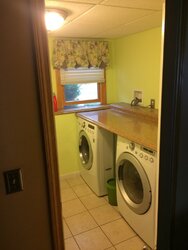Hey guys,
So my basement is air TIGHT. I sprayfoamed the entire foundation wall and the rim joists as well. Therefore, there's no air leaking into the basement.
That being said, my basement is where my electric clothes dryer is located as well as my wood stove (my basement is completely finished).
My problem is that my clothes dryer pulls a ton of air (obviously) and I am getting sick and tired of negative pressure in my basement after washing 3-4 loads of laundry. Do OAKs for dryers exist? I know I could use a weighted balancing damper on a small duct but was wondering if there would be another solution. I always leaves 2 windows open a crack but that isn't fun in the winter time.....
Thanks!
Andrew
So my basement is air TIGHT. I sprayfoamed the entire foundation wall and the rim joists as well. Therefore, there's no air leaking into the basement.
That being said, my basement is where my electric clothes dryer is located as well as my wood stove (my basement is completely finished).
My problem is that my clothes dryer pulls a ton of air (obviously) and I am getting sick and tired of negative pressure in my basement after washing 3-4 loads of laundry. Do OAKs for dryers exist? I know I could use a weighted balancing damper on a small duct but was wondering if there would be another solution. I always leaves 2 windows open a crack but that isn't fun in the winter time.....
Thanks!
Andrew



 Just a $2500 idea.
Just a $2500 idea. . Took a second to figure out what the heck was happening, easy fix, Crack window, done....
. Took a second to figure out what the heck was happening, easy fix, Crack window, done....